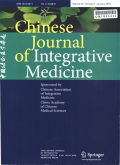- 钛学术文献服务平台 \
- 学术期刊 \
- 医药卫生期刊 \
- 中国医学期刊 \
- 中国结合医学杂志(英文版)期刊 \
null
Pinellia Total Alkaloids Modulate the GABAergic System in Hippocampal Formation on Pilocarpine-Induced Epileptic Rats
基本信息来源于合作网站,原文需代理用户跳转至来源网站获取
摘要:
Objective:To investigate the neuromodulatory effect of pinellia total alkaloids (PTA) on the gamma-aminobutyric acidergic (GABAergic) system in epileptic rats,and preliminarily evaluate the anti-epileptic effect of PTA.Methods:Ninety-one male Sprague-Dawley rats were randomized to a control group (n=17) or an epileptic group (n=74) using computer-generated random numbers.Status epilepticus (SE) was induced with pilocarpine in the epileptic group.Epileptic rats that survived SE were randomly divided into 4 groups,namely an epilepsy group (n=13),a topiramate (TPM,60 mg/kg) group (n=12),a high-dose PTA (800 mg/kg) group (n=12),and a low-dose PTA (400 mg/kg) group (n=10).Treatments were given intragastrically once daily for 14 days.The control group and epilepsy group received normal saline.Spontaneous recurrent seizures (SRSs) were monitored 8-h daily for 7 days after treatment.Then,the hippocampal formation tissues were collected.GABA level was measured using enzyme-linked immunosorbent assay.Protein and mRNA expression levels of glutamate decarboxylase 65 (GAD65),GABA transporter-1 (GAT-1),GABA transaminase (GABA-T),and GABAA receptor (GABAAR) α4,α5,γ2 and δ subunits were measured using Western-blotting analysis and quantitative polymerase chain reaction.Results:PTA lowered the incidence and frequency of SRS (both doses vs.the TPM group,P>0.05).Compared with the epilepsy group,PTA increased the levels of GABA (both doses P<0.01) and GAD65 (mRNA,800 mg/kg,P<0.01),and suppressed the levels of GAT-1 (mRNA,800 mg/kg,P<0.01;400 mg/kg,P<0.05),GABA-T (mRNA,both doses P<0.01),and GABAAR δ subunit (protein,800 mg/kg,P<0.05) and γ2 subunit (protein,both doses P<0.01).PTA upregulated the low-expressed mRNA levels of GABAAR α5 subunit (400 mg/kg,P<0.01),δ subunit (800 mg/kg,P<0.05),and γ2 subunit (400 mg/kg,P<0.05).Conclusions:PTA regulated the GABAergic system through modulating GABA levels and the expression levels of GAD65,GAT-1,GABA-T,and GABAAR α4,α5,γ2 and δ subunits.PTA may exert antiepileptic effects on the pilocarpine-induced epilepsy model.

推荐文章
期刊_丙丁烷TDLAS测量系统的吸收峰自动检测
带间级联激光器
调谐半导体激光吸收光谱
雾剂检漏 中红外吸收峰 洛伦兹光谱线型
不同盐度、温度及光照对漂浮浒苔生理生态的影响
浒苔
盐度
温度
光照
生理生态
期刊_联合空间信息的改进低秩稀疏矩阵分解的高光谱异常目标检测
高光谱图像
异常目标检测 低秩稀疏矩阵分解 稀疏矩阵 残差矩阵
内容分析
关键词云
关键词热度
相关文献总数
(/次)
(/年)
文献信息
| 篇名 | Pinellia Total Alkaloids Modulate the GABAergic System in Hippocampal Formation on Pilocarpine-Induced Epileptic Rats | ||
| 来源期刊 | 中国结合医学杂志(英文版) | 学科 | |
| 关键词 | |||
| 年,卷(期) | 2020,(2) | 所属期刊栏目 | |
| 研究方向 | 页码范围 | 138-145 | |
| 页数 | 8页 | 分类号 | |
| 字数 | 语种 | 英文 | |
| DOI | 10.1007/s11655-019-2944-7 | ||
五维指标
引文网络
引文网络
二级参考文献 (37)
共引文献 (14)
参考文献 (22)
节点文献
引证文献 (0)
同被引文献 (0)
二级引证文献 (0)
1982(1)
- 参考文献(0)
- 二级参考文献(1)
1983(1)
- 参考文献(0)
- 二级参考文献(1)
1986(2)
- 参考文献(0)
- 二级参考文献(2)
1988(1)
- 参考文献(0)
- 二级参考文献(1)
1989(1)
- 参考文献(0)
- 二级参考文献(1)
1990(2)
- 参考文献(0)
- 二级参考文献(2)
1991(1)
- 参考文献(0)
- 二级参考文献(1)
1992(1)
- 参考文献(0)
- 二级参考文献(1)
1993(1)
- 参考文献(0)
- 二级参考文献(1)
1994(3)
- 参考文献(0)
- 二级参考文献(3)
1997(1)
- 参考文献(0)
- 二级参考文献(1)
1998(1)
- 参考文献(0)
- 二级参考文献(1)
1999(3)
- 参考文献(0)
- 二级参考文献(3)
2000(3)
- 参考文献(0)
- 二级参考文献(3)
2001(1)
- 参考文献(1)
- 二级参考文献(0)
2002(4)
- 参考文献(0)
- 二级参考文献(4)
2003(3)
- 参考文献(0)
- 二级参考文献(3)
2004(1)
- 参考文献(0)
- 二级参考文献(1)
2007(3)
- 参考文献(1)
- 二级参考文献(2)
2008(4)
- 参考文献(1)
- 二级参考文献(3)
2009(4)
- 参考文献(2)
- 二级参考文献(2)
2010(2)
- 参考文献(2)
- 二级参考文献(0)
2011(2)
- 参考文献(2)
- 二级参考文献(0)
2012(4)
- 参考文献(4)
- 二级参考文献(0)
2013(3)
- 参考文献(3)
- 二级参考文献(0)
2015(3)
- 参考文献(3)
- 二级参考文献(0)
2016(3)
- 参考文献(3)
- 二级参考文献(0)
2020(0)
- 参考文献(0)
- 二级参考文献(0)
- 引证文献(0)
- 二级引证文献(0)
引文网络交叉学科
相关学者/机构
期刊影响力
中国结合医学杂志(英文版)
主办单位:
中国中西医结合学会
中国中医研究院
出版周期:
月刊
ISSN:
1672-0415
CN:
11-4928/R
开本:
大16开
出版地:
北京西苑操场1号
邮发代号:
82-825
创刊时间:
1995
语种:
eng
出版文献量(篇)
2643
总下载数(次)
0
总被引数(次)
8415
期刊文献
相关文献
推荐文献
- 期刊分类
- 期刊(年)
- 期刊(期)
- 期刊推荐
中国结合医学杂志(英文版)2022
中国结合医学杂志(英文版)2021
中国结合医学杂志(英文版)2020
中国结合医学杂志(英文版)2019
中国结合医学杂志(英文版)2018
中国结合医学杂志(英文版)2017
中国结合医学杂志(英文版)2016
中国结合医学杂志(英文版)2015
中国结合医学杂志(英文版)2014
中国结合医学杂志(英文版)2013
中国结合医学杂志(英文版)2012
中国结合医学杂志(英文版)2011
中国结合医学杂志(英文版)2010
中国结合医学杂志(英文版)2009
中国结合医学杂志(英文版)2008
中国结合医学杂志(英文版)2007
中国结合医学杂志(英文版)2006
中国结合医学杂志(英文版)2005
中国结合医学杂志(英文版)2004
中国结合医学杂志(英文版)2003
中国结合医学杂志(英文版)2002
中国结合医学杂志(英文版)2001
中国结合医学杂志(英文版)2000
中国结合医学杂志(英文版)1999
中国结合医学杂志(英文版)1998
中国结合医学杂志(英文版)2020年第9期
中国结合医学杂志(英文版)2020年第8期
中国结合医学杂志(英文版)2020年第7期
中国结合医学杂志(英文版)2020年第6期
中国结合医学杂志(英文版)2020年第5期
中国结合医学杂志(英文版)2020年第4期
中国结合医学杂志(英文版)2020年第3期
中国结合医学杂志(英文版)2020年第2期
中国结合医学杂志(英文版)2020年第12期
中国结合医学杂志(英文版)2020年第11期
中国结合医学杂志(英文版)2020年第10期
中国结合医学杂志(英文版)2020年第1期

 免费查重
免费查重










